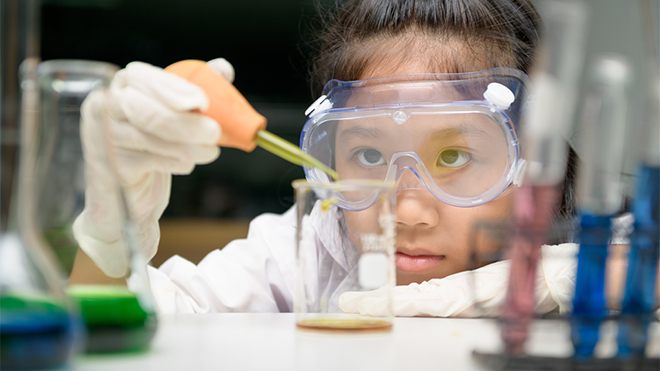Safety Blog
Science/STEM Standard Operating Procedures for a Safer New School Year
By Ken Roy
Posted on 2024-07-17

Disclaimer: The views expressed in this blog post are those of the author(s) and do not necessarily reflect the official position of the National Science Teaching Association (NSTA).
Creating Safer Science/STEM Instructional Spaces
Creating safer laboratory/classroom instructional spaces and related areas (prep rooms, storerooms, etc.) in the upcoming new school year setting involves implementing comprehensive Standard Operating Procedures (SOPs). These SOPs help to mitigate potential safety hazards and resulting health and safety risks inherent in science/STEM instructional spaces involving hands-on activities and demonstrations, in addition to working in related areas.
SOPs to Put in Place for the New School Year
The following are some critical SOPs that should be in place for a new and safer school year. These SOPs are based on legal safety standards from organizations like the Occupational Safety and Health Administration (OSHA), National Fire Protection Association (NFPA), Environmental Protection Agency (EPA), and others, and better professional safety practices from organizations like NSTA, National Science Education Leadership Association (NSELA), International Technology and Engineering Educators Association (ITEEA), American Chemical Society (ACS), and others.
1. Management of Hazardous Chemicals
• Develop protocols for the safer storage, handling, and disposal of hazardous chemicals.
• Appropriately label all chemical containers specifically with appropriate hazard warnings and information, based on OSHA labeling requirements. See OSHA Brief Hazard Communication Standard: Labels and Pictograms at https://www.osha.gov/sites/default/files/publications/OSHA3636.pdf.
• Develop and maintain an up-to-date chemical inventory.
• Make sure appropriate safety signage is posted in instructional spaces and related areas. See OSHA Specifications for accident prevention signs and tags at https://www.osha.gov/laws-regs/regulations/standardnumber/1910/1910.145.
2. Personal Protective Equipment (PPE)
• Require the use of appropriate PPE such as indirectly vented chemical safety goggles or safety glasses with side shields as appropriate meeting the ANSI/ISEA Z87.1 D3 standard; nitrile gloves; lab coats; and closed-toe shoes.
• Provide training on the proper selection, use, and maintenance of PPE.
3. Emergency Procedures
• Establish clear safety protocols for responding to hazardous chemical spills, fires, injuries, and other emergencies.
• Ensure instructional space occupants (all personnel and students) are trained in emergency procedures and evacuation routes.
4. Equipment Safety
• Regularly inspect and maintain instructional space and related areas equipment to ensure safer operation.
• Take any equipment not operating correctly out of use and either repair or replace it.
• Train students on the proper use and maintenance of instructional space equipment.
• Understand the correct operation of instructional space equipment and machinery.
5. Training and Education
• Provide comprehensive safety training for all instructional space personnel, including teachers and support staff. Also provide appropriate safety training for students in the instructional space. They should not be allowed in prep rooms and storerooms.
• Include annual Chemical Hygiene Plan training with a focus on potential chemical hazards and resulting health and safety risks, emergency procedures, safer instructional space practices, and more.
6. Hazard/Risk Assessment
• Conduct regular hazard/risk assessments to identify potential safety hazards and resulting health and safety risks, and implement appropriate control measures as required safety actions.
• Encourage hazard/risk reporting, and provide procedures for students and staff to raise safety concerns.
7. Chemical Hygiene Plan (CHP)
• Develop and implement a Chemical Hygiene Plan (CHP) that outlines procedures for safer chemical purchasing, handling, storage, and disposal.
• Ensure that personnel in all instructional spaces and related areas are familiar with the CHP and adhere to its guidelines, including annual training.
8. Housekeeping
• Maintain housekeeping with clean and organized instructional spaces and related areas to minimize trip/fall hazards and facilitate emergency response.
• Dispose of chemical waste properly and according to regulatory requirements.
9. Supervision and Oversight
• Assign qualified (safety-trained) personnel to supervise activities and demonstrations in instructional spaces and enforce appropriate safety protocols.
• Conduct regular safety inspections and audits to identify areas for improvement.
10. Communication and Collaboration
• Foster open communication among teachers, students, administrators, and safety personnel regarding safety concerns and better professional safety practices.
• Encourage collaboration on safety initiatives, and share lessons learned from incidents or near-misses.
11. Security of Instructional Spaces and Other Designated Areas
All instructional spaces and related areas (lab room, classroom, preparation room, and storeroom) must remain locked in the absence of a designated employee. These areas must be secured, given the biological, chemical, and physical hazards.
12. Engineering Controls
Required instructional spaces and related areas engineering controls include a goggle sanitizer cabinet, fire extinguishers [ABC, D Types (as appropriate)], fire blanket, eyewash station, drench type safety shower, machine guards, and exhaust hood.
13. Electrical Safety
• Use ground fault circuit interrupters (GFCIs) for equipment being used near water sources.
• Ensure that electrical cords and outlets are in good condition and not overloaded or draped across the walkways.
14. Personal Hygiene
• Encourage students to wash their hands thoroughly with soap and water after handling chemicals or biological materials.
• Prohibit eating, drinking, or applying cosmetics in the instructional space.
In the End
By planning ahead and implementing these SOPs, teachers can help ensure a safer instructional space environment for students, teachers, and staff throughout the new school year. OSHA’s Occupational Exposure to Hazardous Chemicals in Laboratories or Lab Standard 29 CFR 1910.1450 (https://www.osha.gov/laws-regs/regulations/standardnumber/1910/1910.1450) and OSHA’s Hazard Communication Standard 29 CFR 1910.1200 (https://www.osha.gov/laws-regs/regulations/standardnumber/1910/1910.1200) provide many additional SOPs for academic science/STEM instructional spaces and related areas as legal safety standards.
As for better professional safety practices, the NSTA Safety Advisory Board has developed a number of instructional spaces and related areas practices in safety resources; see https://www.nsta.org/topics/safety#tab.
For additional information on this topic, see Are Your Lab SOPs in Place for a Safer School Year? at https://www.nsta.org/blog/are-your-lab-sops-place-safer-school-year.
Submit questions regarding safety to Ken Roy at safersci@gmail.com. Follow Ken Roy on X.com: @drroysafersci.
Safety Technical and Vocational Education Elementary Middle School High School Postsecondary Informal Education

